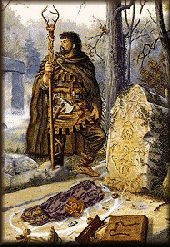 The Bardic Order The Bardic Order- A poet, especially one who writes impassioned, lyrical, or epic verse. Bards were originally Celtic composers of eulogy and satire; the word came to mean more generally a tribal poet-singer gifted in composing and reciting verses on heroes and their deeds. As early as the 1st century AD, the Latin author Lucan referred to bards as the national poets or minstrels of Gaul and Britain.
-
 In Gaul the institution gradually disappeared, whereas in Ireland and Wales it survived. The Irish bard through chanting preserved a tradition of poetic eulogy. In Wales, where the word bardd has always been used for poet, the bardic order was codified into distinct grades in the 10th century. Despite a decline of the order toward the end of the European Middle Ages, the Welsh tradition has persisted and is celebrated in the annual eisteddfod, a national assembly of poets and musicians. In Gaul the institution gradually disappeared, whereas in Ireland and Wales it survived. The Irish bard through chanting preserved a tradition of poetic eulogy. In Wales, where the word bardd has always been used for poet, the bardic order was codified into distinct grades in the 10th century. Despite a decline of the order toward the end of the European Middle Ages, the Welsh tradition has persisted and is celebrated in the annual eisteddfod, a national assembly of poets and musicians.-
 The Eisteddfod The Eisteddfod- The Eisteddfod (plural Eisteddfods, or Eisteddfodau) is a formal assembly of Welsh bards and minstrels that originated in the traditions of court bards of medieval times. The modern National Eisteddfod, revived in the 19th century and held each summer alternately in a site in North or South Wales, has been broadened to include awards for music, prose, drama, and art, but the chairing and investiture of the winning poet remains its high point.
-
- Earlier assemblies were competitions of musicians (especially harpists) and poets from which new musical, literary, and oratorical forms emerged. The assembly at Carmarthen (1451) is famous for establishing the arrangement of the strict metres of Welsh poetry in forms that are still authoritative. In the 17th century the custom fell into disuse, though poetry remained a popular art and a form of eisteddfod survived in informal gatherings of rhymesters who met to compose verses on impromptu subjects. In the 18th century, when local eisteddfods were revived, it was apparent that many ordinary farmers and workingmen were still sufficiently skilled in the complicated craftsmanship of bardic versification to win prizes. In the 19th century the eisteddfod exerted a dominant influence on Welsh poetry through its annual national assembly and a number of local competitions. Though it succeeded in preserving the bardic forms, the quality of eisteddfod poetry was normally mediocre and degenerated to its lowest level in the late 19th century.
-
- The subjects assigned for the competition were celebrations of Welsh history or the Welsh countryside, biblical subjects such as the Creation or the Resurrection, or abstract subjects, such as almsgiving. Such poetry was necessarily impersonal and resulted in lengthy, descriptive compositions in which form was the major concern and content and emotional depth were secondary. With World War I and the Depression, in which Wales was particularly hard hit, many Welsh poets turned to more personal and relevant poetry, and the eisteddfod became primarily a forum for a youthful poet to gain a hearing.
-
 The Awdl The Awdl- In Welsh verse, a long ode written in cynghanedd (a complex system of alliteration and internal rhyme) and in one or more of the 24 strict bardic metres, though only 4 bardic metres are commonly used. The awdl was, by the 15th century, the vehicle for many outstanding Welsh poems. It remains the predominant form in the annual national eisteddfod (bard and minstrel competition); since 1887 a wooden chair (the chair is the Welsh bard's highest honour) has been awarded the writer of the winning awdl. Despite the criticism advanced by some that the form is obsolete, awdlau of high poetic merit are still occasionally written.
|
![]()
![]()
No comments:
Post a Comment